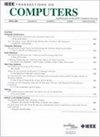ParBFT: An Optimised Byzantine Consensus Parallelism Scheme
IF 3.6
2区 计算机科学
Q2 COMPUTER SCIENCE, HARDWARE & ARCHITECTURE
引用次数: 0
Abstract
Byzantine fault-tolerance (BFT) consensus is a fundamental building block of distributed systems such as blockchains. However, implementations based on classic PBFT and most linear PBFT-variants still suffer from message communication complexity, restricting the scalability and performance of BFT algorithms when serving large-scale systems with growing numbers of peers. To tackle the scalability and performance challenges, we propose ParBFT, a new Byzantine consensus parallelism scheme combining classic BFT protocols and a novel Bilevel Mixed-Integer Linear Programming (BL-MILP)-based optimisation model. The core aim of ParBFT is to improve scalability via parallel consensus while providing enhanced safety (i.e. ensuring consistent total order across all correct replicas). Another core novelty is the integration of the BL-MILP model into ParBFT. The BL-MILP allows us to compute optimal numerical decisions for parallel committees (i.e. the optimal number of committees and peer allocation for each committee) and improve consensus performance while ensuring security. Finally, we test the performance of the proposed ParBFT on Microsoft Azure Cloud systems with 20 to 300 peers and find that ParBFT can achieve significant improvement compared to the state-of-the-art protocols.一种优化的拜占庭共识并行方案
本文章由计算机程序翻译,如有差异,请以英文原文为准。
求助全文
约1分钟内获得全文
求助全文
来源期刊

IEEE Transactions on Computers
工程技术-工程:电子与电气
CiteScore
6.60
自引率
5.40%
发文量
199
审稿时长
6.0 months
期刊介绍:
The IEEE Transactions on Computers is a monthly publication with a wide distribution to researchers, developers, technical managers, and educators in the computer field. It publishes papers on research in areas of current interest to the readers. These areas include, but are not limited to, the following: a) computer organizations and architectures; b) operating systems, software systems, and communication protocols; c) real-time systems and embedded systems; d) digital devices, computer components, and interconnection networks; e) specification, design, prototyping, and testing methods and tools; f) performance, fault tolerance, reliability, security, and testability; g) case studies and experimental and theoretical evaluations; and h) new and important applications and trends.
 求助内容:
求助内容: 应助结果提醒方式:
应助结果提醒方式:


